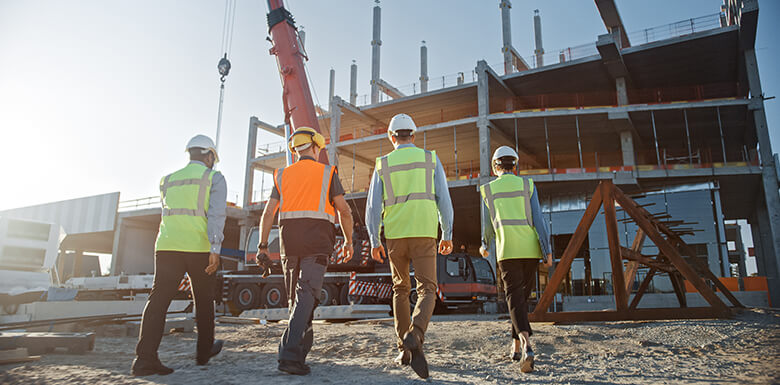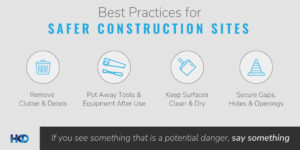May 11, 2021
Common Causes of Slips, Trips, and Falls on Construction Sites
By Jonathan Damashek
Posted in

Slips, trips, and falls are common on construction sites in New York City. In fact, according to the Occupational Safety and Health Administration, slip, trip, and fall accidents are among the leading causes of construction workplace injuries.
Many of these accidents are preventable. Whether it is an unstable walkway, debris, or unsafe conditions, a construction injury lawyer can help you recover damages from an accident that was not your fault.
What Causes Most Slip, Trip, and Fall Accidents?
OSHA requires that employers protect against hazards in the workplace. Despite this, slip, trip, and fall accidents happen, and people get injured.
Some common causes of slips, trips, and falls on construction sites include:
- Slick spots on walking surfaces
- Debris
- Clutter
- Unsafe stairs or ladders
- Improperly structured scaffolding
- Sloped walking surfaces
- Loose, unanchored flooring
- Ramps without skid- or slip-resistance surfaces
- Mounting and dismounting vehicles and equipment
- Loose, irregular surfaces such as gravel
- Weather hazards
- Uncovered hoses, cables, or wires
- Poor lighting
Falling objects are another hazard that contributes to workplace accidents. Employers should ensure that construction sites and other workplaces are safe, with proper equipment provided to employees. Construction sites should be ADA compliant when required by law.
OSHA Standards Violations Lead to Slips, Trips, and Falls
When employers fail to comply with OSHA standards, they create a dangerous work environment for employees. In 2019, OSHA reported that three of the top 10 most frequently cited OSHA standards that were violated involved fall protection or scaffolding requirements.
In 2019, the most recent year reported, more than 5,300 workers died on the job. That is approximately 100 per week or 15 per day. About 20% – 1,061 – of worker fatalities are construction deaths. Many of those were due to slips, trips, and falls.

Preventing Slips, Trips, and Falls Is Good Business
The best way to deal with these accidents is to prevent them. Employers can prevent slip and fall accidents by ensuring safety equipment is available on work sites. They can also provide appropriate training for employees.
The following are suggested measures that may prevent slip, trip, and fall accidents on New York City construction sites.

Best Practices to Prevent Falls on Contruction Sites
The Occupational Safety and Health Administration (OSHA) mandates that walkways and driveways should be obstruction-free, in good repair, and adequately spacious. Key practices include:
- Removing clutter and debris.
- Storing tools and equipment properly after use.
- Promptly addressing potential dangers.
- Allowing time for workers to clean and organize the work area within working hours.
Maintain Clean and Dry Surfaces
Keeping outdoor surfaces clean and dry is crucial, using treatments like sand, salt, and anti-skid adhesives when necessary. Indoor surfaces benefit from non-slip mats and maintaining cleanliness to prevent hazards from construction work boots.
Ensure Structural Safety
Secure any gaps, holes, and openings, following OSHA definitions and guidelines. Use covers, railings, and toe boards to prevent falls through these spaces.
Special Focus: Roof Safety
Working on roofs presents unique challenges. To enhance safety:
- Never work alone on a roof.
- Avoid working in adverse weather conditions like snow, rain, or thunderstorms.
- Stay off wet roofs to prevent slips.
- Use appropriate safety gear, including harnesses, hardhats, safety glasses, and sturdy footwear. Regularly inspect all fall protection equipment.
- Implement safety systems like guard rails or controlled access zones as per OSHA standards.
- Keep roofs free from tools and materials that can cause accidents.
- Work cautiously and avoid rushing.
Stairs and Ladders Safety
Stairs and ladders are common sites for accidents. To mitigate risks:
- Always use handrails.
- Ensure areas are well-lit.
- Maintain clear visibility.
- Conduct regular inspections and repairs.
- Clean up moisture and spills immediately.
- Remove or repair defective equipment.
- Use ladders and other equipment as intended and on stable surfaces.
For a more in-depth understanding of fall prevention, the OSHA “Fall Prevention Guide” is available for download. This guide provides comprehensive safety measures, especially for work involving elevation like ladders, scaffolds, and roofs. Remember, safety is a continuous effort and requires the participation of everyone on site.
Injured on Site? Get Medical and Legal Help
Always get medical help if you are injured at work in a slip, trip, or fall accident or any kind of construction accident. After you talk to your healthcare provider, call Hecht, Kleeger & Damashek for a free consultation. You may be able to recover damages for injuries caused by another party’s negligence or wrongdoing.
Call our construction accident lawyers at (212) 490-5700 or use our online contact form for a free consultation.